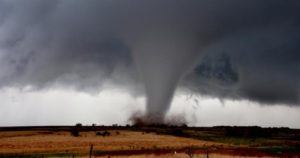Less than a decade ago, Victor Gensini was a student at Northern Illinois University studying meteorology.
After earning a bachelor’s degree in meteorology and a master’s degree in geography at NIU, he earned his Ph.D. from the University of Georgia and taught at the College of DuPage for five years. Now, he is back at his alma mater to teach and research weather and climate.
“NIU represents, to me, the ability to reach a very wide spectrum of people, from rural areas to the urban metropolitan area of Chicago,” Gensini said. “There’s a lot of people bringing different things to the table, which is one of the things I liked about NIU as a student.”
Gensini is now collaborating with his former advisor, professor Walker Ashley, to research large thunderstorm complexes and how these phenomena might change under future climate change scenarios. This work will be funded with a $400,000 grant from the National Science Foundation.

“The idea is to try and track not only how big clusters have gotten in the past, (but) how the atmosphere may or may not affect weather occurrences in the near future,” Gensini said.
His work in predicting the likelihood of tornadoes weeks in advance received national attention last year. A contributing factor in tornado formation during spring storm activity is the jet stream, which provides the necessary ingredient of wind shear to a tornado, he said.
“Every tornado leaves behind a fingerprint in the conditions that are present when the outbreak occurs, which us researchers can then use to go back in history and find similar conditions when tornadoes were occurring,” Gensini said. “If we can know the environment, we can better forecast when (tornadoes) might occur.”
When he isn’t doing research, Gensini will be teaching two classes for the fall semester: an introductory course on weather called “Weather Climate And You” and a more advanced junior meteorology course.
One thing to realize in the general education class is that 90 percent of the students are not going to be an atmospheric science major, Gensini said.
“You have to make them understand why it’s important and why it will play a role in day-to-day life,” he said. “One example I gave the first day of class was that every time you step out the classroom door and walk to your apartment or your car, the atmosphere will influence you. These are basic things a student can grab onto.”
Other topics, such as how the weather affects the economy and taxpayers, the results of devastating storms like Hurricane Harvey and Hurricane Irma, and the political debate around climate change are also discussed. From a local perspective, Gensini will also discuss the damage from the 2015 tornado that struck Fairdale, killing two women.
“I try to bring as much real-world application into the classroom as I can,” Gensini said.
Was this article valuable?
Here are more articles you may enjoy.


 LA Fires Push Insurers’ 2025 Disaster Losses to $107 Billion
LA Fires Push Insurers’ 2025 Disaster Losses to $107 Billion  Trump Sues BBC for $10 Billion Over Documentary Edit
Trump Sues BBC for $10 Billion Over Documentary Edit  Twice Injured Firefighter Loses Second Workers’ Compensation Claim
Twice Injured Firefighter Loses Second Workers’ Compensation Claim  Jump Trading Faces $4 Billion Terraform Administrator Suit
Jump Trading Faces $4 Billion Terraform Administrator Suit 